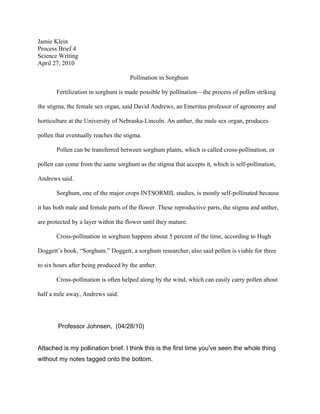
Pollination Process Klein
- 1. Jamie Klein Process Brief 4 Science Writing April 27, 2010 Pollination in Sorghum Fertilization in sorghum is made possible by pollination—the process of pollen striking the stigma, the female sex organ, said David Andrews, an Emeritus professor of agronomy and horticulture at the University of Nebraska-Lincoln. An anther, the male sex organ, produces pollen that eventually reaches the stigma. Pollen can be transferred between sorghum plants, which is called cross-pollination, or pollen can come from the same sorghum as the stigma that accepts it, which is self-pollination, Andrews said. Sorghum, one of the major crops INTSORMIL studies, is mostly self-pollinated because it has both male and female parts of the flower. These reproductive parts, the stigma and anther, are protected by a layer within the flower until they mature. Cross-pollination in sorghum happens about 5 percent of the time, according to Hugh Doggett’s book, “Sorghum.” Doggett, a sorghum researcher, also said pollen is viable for three to six hours after being produced by the anther. Cross-pollination is often helped along by the wind, which can easily carry pollen about half a mile away, Andrews said. Professor Johnsen, (04/28/10) Attached is my pollination brief. I think this is the first time you've seen the whole thing without my notes tagged onto the bottom.
- 2. Jamie